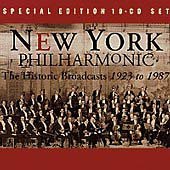The New York "Phil": overrated as usual
madamemusico | Cincinnati, Ohio USA | 10/19/2000
(3 out of 5 stars)
"I have often thought that symphony orchestras with a long history, i.e. Boston, Chicago, Philadelphia, Cincinnati etc., should put out albums of historic broadcasts, but so far only the N.Y. Philharmonic has done so. The quality of the transfers, booklet, musician quotes and packaging are first-rate. The performances are something else again.As anyone who has worked with, for or around the NY Phil can tell you, this is and has always been one arrogant orchestra. By this I mean, the musicians think they know everything, they act in a high-handed manner with outsiders, and they have always given conductors a hard time. If NY musicians don't like you or your approach to music, they will "sabotage" your performances--in fact, they did so to John Barbirolli, Artur Rodzinski and Dmitri Mitropoulos--and even if they like you (as in the case of Leonard Bernstein) they won't produce a really fine tone or ensemble blend, but rather a kind of rag-rag sound with rough-sounding strings and blowsy brass. If you don't believe me, just listen to the performances herein by Barbirolli, Rodzinski and Igor Stravinsky, whom one NY Phil musician describes as "a funny little man" but not a good conductor. (Gee, that's odd, I heard the transcript of Stravinsky conducting the world premiere of "The Rake's Progress" and it was a very adequate performance.)Only seven conductors on this set draw a really fine sound from the orchestra: Mengelberg, Toscanini, Walter, Cantelli, Monteux, Reiner and Kubelik, and they were among the greatest conductors who ever lived. Everyone else gets so-so sound or worse, clumsily-phrased performances, and sometimes mismatched styles (worst of them being the Mozart Concerto No. 7 for 2 Pianos, where the prissy conducting of Barbirolli is overpowered by Josef and Rosina Lhevinne poundin' away on the ivories like they were having a break-your-eardrums contest).Artistically, there is about four and a half hours' worth of great music AND great performances out of the 12 1/2 hours presented. Best of the lot are Beethoven's "Coriolanus" overture (somewhat abridged) by Willem van Hoogstraten (a fine testament to a completely forgotten conductor), all of the Toscanini material (including the best Brahms Violin Concerto I've ever heard and an arrangement of Bach's Toccata and Fugue by Sir Henry Wood that actually simulates the timbral sounds of an organ), the Chopin Concerto No. 1 by Rubinstein and Walter, the Shostakovich Violin Concerto No. 1 by Oistrakh and Mitropoulos (the orchestra didn't have much to do, and behaved itself out of respect for Oistrakh), the Faure Requiem conducted by Nadia Boulanger (with a sublime-sounding Donald Gramm), the Three Orchestral Pieces of Berg conducted by Bernstein, and Bartok's opera "Duke Bluebeard's Castle" with Tatiana Troyanos, Siegmund Nimsgern and Kubelik. In retrospect, and out of respect to the work they did, I feel that more Bernstein performances should have been included and something by Michael Tilson Thomas should have made it in. Granted, Lennie often flew by the seat of his pants in live performance, but certainly they could have found SOMETHING in their vaults better than, say, the atrocious Schoenberg "Ode to Napoleon," Poulenc's thoroughly dry and uninteresting "Concert champetre," the afore-mentioned Mozart Concerto for 2 Pianos, Roberta Peters in poor voice caterwauling her way through the "Fledermaus" arias, or John Corigliano's derivative and poorly-constructed Clarinet Concerto? Alas, we'll never know.One final note: $220 strikes me as prohibitively expensive for a 10-CD set. Since when are CDs worth $22 apiece? Trust me, they are NOT made of gold. In any case, your decision to purchase should weigh the relative merits and importance of the good performances, and decide whether or not they are worth that much to you. Certainly, this is the best "Bluebeard's Castle" I have ever heard, Bruno Walter's muscular reading of the Chopin Concerto must be heard to be believed, and the Toscanini performances have the advantage of giving us his sound in "real space" rather than a cramped studio. These are also advantages to consider. The choice is yours. I have simply given it my own personal rating."

